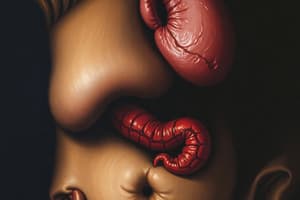Podcast
Questions and Answers
What is the most common cause of pancreatitis?
What is the most common cause of pancreatitis?
- Alcohol abuse (correct)
- Trauma
- Cholelithiasis (correct)
- Hyperlipidemia
What are the signs of gallbladder obstruction in cholecystitis?
What are the signs of gallbladder obstruction in cholecystitis?
Palpable GB, Murphy’s sign, Boas sign
Chronic cholecystitis is associated exclusively with gallstones.
Chronic cholecystitis is associated exclusively with gallstones.
False (B)
In pancreatitis, Gray Turner sign indicates _____ bruising.
In pancreatitis, Gray Turner sign indicates _____ bruising.
Which of the following best describes biliary colic?
Which of the following best describes biliary colic?
What is a common initial imaging test for cholecystitis?
What is a common initial imaging test for cholecystitis?
What laboratory finding is commonly associated with acute cholecystitis?
What laboratory finding is commonly associated with acute cholecystitis?
Cholecystectomy is always performed as an emergency procedure.
Cholecystectomy is always performed as an emergency procedure.
Name a sign that indicates perforation during abdominal assessment.
Name a sign that indicates perforation during abdominal assessment.
What complication may arise from delayed treatment of biliary obstruction?
What complication may arise from delayed treatment of biliary obstruction?
Flashcards
Cholecystitis
Cholecystitis
Inflammation of the gallbladder, often caused by gallstones blocking the cystic duct.
Acute Cholecystitis
Acute Cholecystitis
Sudden, severe gallbladder pain, usually due to gallstones.
Chronic Cholecystitis
Chronic Cholecystitis
Repeated attacks of gallbladder pain, often due to gallstones.
Murphy's sign
Murphy's sign
Signup and view all the flashcards
Gallstones
Gallstones
Signup and view all the flashcards
Cholecystectomy
Cholecystectomy
Signup and view all the flashcards
Pancreatitis
Pancreatitis
Signup and view all the flashcards
Acute Pancreatitis
Acute Pancreatitis
Signup and view all the flashcards
Chronic Pancreatitis
Chronic Pancreatitis
Signup and view all the flashcards
Amylase
Amylase
Signup and view all the flashcards
Lipase
Lipase
Signup and view all the flashcards
ERCP
ERCP
Signup and view all the flashcards
HIDA scan
HIDA scan
Signup and view all the flashcards
CT
CT
Signup and view all the flashcards
Sentinel loop
Sentinel loop
Signup and view all the flashcards
Study Notes
Cholecystitis
- Gallbladder (cystic duct) obstruction by stone leads to inflammation/infection.
- 50-80% of cases are caused by E. coli.
- Acute acalculous cholecystitis is more common in critically ill patients and is often caused by biliary stasis.
- Chronic cholecystitis is often associated with gallstones and can lead to a thickened gallbladder wall.
- MCC: cholelithiasis or alcohol abuse (chronic).
Pancreatitis
- Can be caused by trauma, hyperlipidemia, drugs, hypercalcemia, penetrating peptic ulcers, or medications.
- Chronic pancreatitis involves loss of endocrine function and damage to the gland (fibrosis, calcification, ductal inflammation).
- Acute pancreatitis is often related to gallstones or alcohol use.
- Severe tearing pain during bowel movements can accompany pancreatitis.
- Symptoms include: upper abdominal pain radiating to the back, pain better with leaning forward or sitting, nausea and vomiting, dehydration/shock, and occasionally peritonitis.
Anal Fissure
- Painful linear lesions in the distal anal canal.
- Most commonly located in the posterior midline.
- May involve the full thickness of the mucosa if left untreated.
- Associated symptoms include painful bowel movements, bright red blood on stools or toilet paper, and chronic skin tags.
Anorectal Abscess/Fistula
- Caused by bacterial infection of anal ducts/glands.
- Common symptoms: throbbing rectal pain, worsened by sitting, coughing, or bowel movements.
- Usual pathogens are S. aureus and E. coli.
- Usually located in the posterior midline.
Appendicitis
- Obstruction of the appendix is a common cause.
- Common causes include: fecaliths, inflammation, malignancy, foreign bodies.
- Most common in 10-30 year olds.
Bariatric Surgery
- Used to maintain weight loss and reduce obesity-related issues in cases where other methods have failed.
- BMI > 40, or ≥35 with comorbid conditions.
- Individuals should be psychologically stable to follow post-operative instructions.
- Complications: regurgitation, prolapse, esophageal dilation, dumping syndrome.
Bowel Obstruction
- Small Bowel Obstruction (SBO): Usually from adhesions, hernias, neoplasms, IBD, or volvulus.
- Large Bowel Obstruction (LBO): Often from neoplasms, strictures, hernias, volvulus, or intussusception, fecal impaction.
- Common symptoms: abdominal pain, distention, SBO has high-pitched tinkles, visible peristalsis, LBO has less active sounds
- XR shows air fluid levels in step ladder patterns; CT if unclear.
- Severe mechanical obstruction requires urgent surgical consultation.
Appendicitis
- Appendicitis most commonly occurs in individuals aged 10-30 years old.
- Characteristic symptoms include anorexia, periumbilical pain that becomes constant and more severe in the RLQ (McBurney's point), nausea and vomiting, low-grade fever, rebound tenderness.
- A 20% chance of perforation or peritonitis, which is severe generalized abdominal pain + increased WBC + fever.
Volvulus
- Twisting of a loop of bowel
- Most common location is the sigmoid colon.
- Risk factors for cecum volvulus: chronic constipation, medications that inhibit gut motility, prior abdominal surgery.
Primary Sclerosing Cholangitis
- Autoimmune, progressive cholestasis with diffuse fibrosis of the intrahepatic and extrahepatic ducts.
- It is frequently associated with inflammatory bowel disease, most patients will have Ulcerative colitis.
Ascending Cholangitis
- Biliary tract infection caused by gallstone obstruction.
- Commonly from choledocholithiasis.
- Presentation of s/s may include RUQ pain, jaundice, fever.
- Reynolds Pentad: Includes shock, altered mental status (AMS) with the Charcot's triad.
Cholelithiasis
- Asx gallstones, 90% are cholesterol stones; 5-10% are pigmented stones.
Diarrhea
- Increased frequency or volume of stools for ≥2-3 consecutive days.
- Different types include inflammatory, secretory, osmotic (large volumes w/o inflammation) , and malabsorptive.
- Inflammatory (bloody, w fever, dysentery) suggests invasive organisms or IBD.
Esophageal Neoplasms
- Squamous cell carcinoma
- Commonly associated with tobacco and alcohol use; decreased veggie and fruit consumption.
- Adenocarcinoma
- More common in younger patients.
- MC in lower 1/3 of esophagus.
- RF: GERD, Barrett's esophagus, obesity.
Esophageal Strictures
- Complication of GERD/ Barrett's esophagus/ obesity that causes narrowing in the esophagus.
Gastric Carcinoma
- Adenocarcinoma is MC.
- SQUAMOUS cell carcinoma is less common •RF: H. pylori, salted, cured, smoked, pickled foods. •S/s: dysphagia with solids, indigestion, weight loss, early satiety.
Constipation
- Decreased stool volume + increased stool firmness with straining.
- Diverticulitis: Inflammation of diverticula, commonly in sigmoid & descending colon, caused by obstruction/fecaliths.
Studying That Suits You
Use AI to generate personalized quizzes and flashcards to suit your learning preferences.





